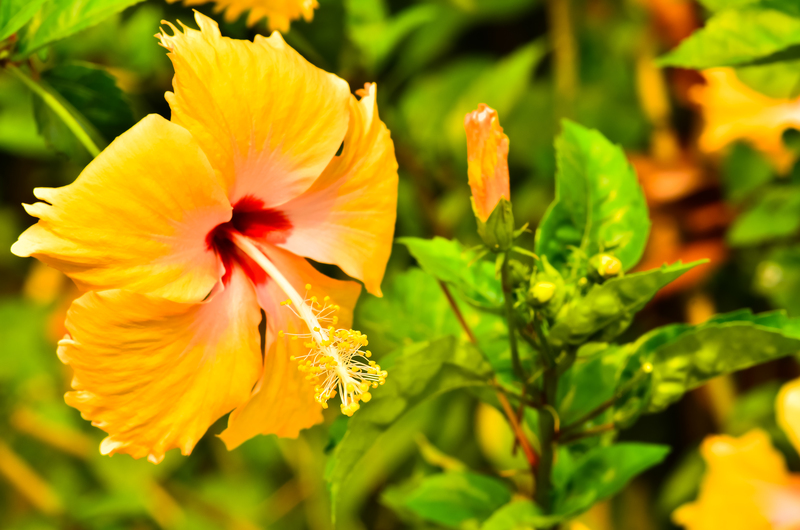Explore the Intricacies of Orchid Cultivation
Posted on 19/05/2025
Explore the Intricacies of Orchid Cultivation
Orchids are often admired for their delicate beauty and remarkable diversity. Their cultivation, however, is a rewarding journey that demands both patience and precision. Whether you are a seasoned horticulturist or a beginner eager to introduce these captivating flowers into your home, understanding the complex tapestry of orchid cultivation can pave the way for a thriving, vibrant collection. In this comprehensive guide, we'll explore the intricacies of growing orchids--from the unique characteristics of orchid species to their specific care needs, and the common challenges growers face.

Understanding Orchids: Botanical Wonders of the Plant World
The world of orchids is vast, comprising more than 25,000 species and over 100,000 hybrids. From the ice-capped mountains to lush rainforests, orchids have adapted to nearly every environment on Earth, making their cultivation both an art and a science.
- Epiphytic Orchids (e.g., Phalaenopsis, Dendrobium): Grow on trees, derive nutrients and moisture from the air.
- Terrestrial Orchids (e.g., Paphiopedilum, Cymbidium): Grow in soil, requiring specific mediums and more conventional care.
- Lithophytic Orchids: Thrive on rocks, extracting nutrients from rainwash and decomposition.
The diverse adaptations of these species underline the importance of knowing your orchid's natural origin, as it directly influences their ideal cultivation conditions.
Setting the Stage: The Right Environment for Orchid Growth
Light Requirements: Balancing Sunlight and Shade
Orchids possess unique light needs that hinge on their species. While Phalaenopsis (moth orchids) thrive in indirect, filtered sunlight, Cattleya orchids require brighter conditions with some morning sun. Insufficient light stifles blooming, whereas excessive sunlight leads to scorched leaves. The trick is to observe your plant closely--leaves should be a warm, light green as opposed to dark green (indicative of too little light) or yellowish (too much light).
- East-facing windows are typically ideal for most indoor orchids.
- Consider artificial grow lights if natural light is inconsistent.
- Rotate your orchids occasionally to encourage even growth.
Temperature and Humidity: Mimicking the Natural Habitat
Most commonly cultivated orchids prefer daytime temperatures between 65-80?F (18-27?C) and slightly cooler nights. Humidity, another crucial component, should range from 40-70% depending on the species. A warm, humid environment not only mirrors their native habitats but also fosters healthy growth.
Tips to maintain optimal conditions:
- Use a humidity tray or room humidifier in dry climates.
- Ensure air circulation with a small fan to prevent fungal diseases.
- Never expose orchids to drafts or abrupt temperature changes--stability is key.
Growing Mediums: From Bark to Moss
Orchids rarely thrive in typical potting soil. Instead, specialized orchid growing mediums replicate their native environments. Popular choices include:
- Pine Bark: Excellent drainage and aeration, suitable for epiphytes such as Cattleya and Oncidium.
- Sphagnum Moss: Retains moisture, ideal for Phalaenopsis and seedling orchids.
- Coconut Husk Chips: Durable and slow to decompose, great for extended moisture retention.
- Leca (Lightweight Expanded Clay Aggregate): Used in semi-hydroponic orchid cultivation for more controlled watering.
Selecting the right potting medium is pivotal--tailor it to both the orchid species and your watering habits. Well-draining is a must to prevent root rot.
The Art of Watering Orchids: Frequency and Method
One of the primary challenges in successful orchid cultivation is developing a watering routine that balances the plant's needs. Too little water leads to shriveled, stressed roots, whereas over-watering hurriedly results in root rot--a common death sentence for these sensitive plants.
How Often Should You Water Orchids?
- Most orchids require watering once a week, but frequency can increase during hot, dry periods and decrease in winter.
- Phalaenopsis orchids prefer their roots to dry out between waterings, whereas Paphiopedilum species like more consistent moisture.
- Always observe the roots and potting medium--water when the medium is nearly, but not completely, dry.
The Best Watering Techniques for Orchids
- Water early in the day to allow foliage to dry before nightfall.
- Use lukewarm, filtered water to avoid mineral buildup.
- Soak thoroughly: Run water through the pot until it drains freely from the bottom.
- Avoid letting water sit in the crown of the plant to prevent rot.
Feeding Your Orchids: Fertilizer Essentials
Unlike many houseplants, orchids require a specialized feeding regimen. Their slow-growing roots and unique nutritional needs mean that standard plant fertilizers often fall short.
Choosing the Right Fertilizer
- Opt for a balanced, water-soluble orchid fertilizer, such as 20-20-20.
- During active growth phases (spring and summer), feed every two weeks. In winter, reduce feeding to monthly.
- "Weakly, weekly": Apply fertilizer at half the recommended strength to avoid harmful salt buildup.
- Flush the potting medium monthly with plain water to wash away excess salts.
Repotting Orchids: Why, When, and How
Orchids frequently require repotting to maintain healthy roots and promote growth. Signs your orchid needs repotting include roots spilling over the pot, decomposed medium, stunted growth, or a top-heavy appearance.
Steps for Repotting Orchids
- Choose the right time. Repot just after flowering or during active root growth for the least stress.
- Gently remove the orchid from its current pot, teasing away any old potting medium.
- Trim dead or mushy roots with sterilized scissors.
- Place the plant in a slightly larger pot with fresh medium, positioning roots carefully to avoid crowding.
- Water lightly after repotting to help settle the medium and roots.
Orchid Propagation: Expanding Your Collection
For the devoted grower, propagation unveils yet another layer in the intricate world of orchids. While some techniques require finesse and patience, even beginners can try their hand at multiplying their orchid collection.
Common Propagation Methods
- Division: Separating mature orchids (such as Cymbidium or Dendrobium) into clumps, each with several healthy pseudobulbs and roots.
- Keiki Promotion: A keiki is a plantlet that forms on the flower spike, especially in Phalaenopsis. Once it develops roots, it can be removed and potted individually.
- Backbulb Propagation: In sympodial orchids, old (leafless) pseudobulbs sometimes give rise to new growth when placed in a moist medium.
Advanced enthusiasts may also explore tissue culture or meristem propagation, although these are best left to experts due to their complexity.
Common Orchid Problems and Solutions
While steadfast care avoids most issues, even skilled cultivators can encounter challenges in orchid cultivation. Learning to diagnose and treat problems swiftly ensures your collection remains healthy and beautiful.
Pest Management
- Aphids, mealybugs, and spider mites are common orchid pests. Treat infestations quickly with insecticidal soap or neem oil.
- Isolate affected plants to prevent pests from spreading to healthy orchids.
- Regularly inspect new plants and incoming potting materials to keep pests at bay.
Disease Prevention
- Root rot occurs from overwatering--ensure your medium drains well and always empty saucers after watering.
- Leaf spot and fungal infections can be mitigated by providing good air circulation and removing affected leaves promptly.
- Sterilize all tools before pruning or dividing orchids to halt the spread of pathogens.
Blooming Problems and Their Remedies
- No blooms? It could be insufficient light, inadequate nutrition, or an incorrect rest period. Adjust care and be patient--many orchids bloom only once a year.
- Bud blast (when buds fall off before opening) is typically a result of sudden temperature changes, inconsistent watering, or humidity drops.
- After-bloom care is essential. Do not remove healthy spikes unless they are brown. Some varieties will rebloom on old spikes.
Specialized Orchid Cultivation Techniques
Semi-Hydroponic Orchid Growing
Innovative growers may explore semi-hydroponic setups using LECA beads and self-watering containers. This method provides constant but controlled water access, ideal for those prone to over- or under-watering.
- Rinse LECA beads before use to remove dust.
- Ensure the water reservoir does not submerge the root system fully, preventing rot.
- Adjust fertilizer regime to suit more frequent washing in hydroponic methods.
Outdoor Orchid Cultivation
Many orchid species flourish outdoors in subtropical and tropical zones. Growers in colder climates can move orchids outside in summer for improved vigor and blooming.
- Acclimatize gradually to prevent shock from sudden exposure to elements.
- Shield from direct noon sun and shelter during rainstorms to avoid waterlogged pots.
- Monitor for pests and temperature fluctuations.

The Joy and Rewards of Orchid Cultivation
To cultivate orchids is to embark on a fascinating, challenging, and ultimately enriching botanical journey. These flowers, with their intricate forms and diverse habits, inspire patience, observation, and learning. Each successful bloom is not just a testament to your gardening skill, but also a reward for your commitment to understanding their unique ways.
Whether your collection consists of one cherished Phalaenopsis or a greenhouse filled with exotic rarities, the world of orchid cultivation offers endless opportunity for discovery. Nurture your plants with care, stay curious, and enjoy every stage of their remarkable lifecycle.
Conclusion: Mastering the Fine Art of Growing Orchids
Exploring the intricacies of orchid cultivation reveals a world of subtle nuances and careful practices. With the right approach--attending to light, water, temperature, feeding, and pests--you arm yourself with the knowledge needed to grow healthy, prolific orchids. As you deepen your understanding and expand your collection, you join a global community of enthusiasts who appreciate both the challenge and the joy these mesmerizing plants bring.
- Observe and respond to your orchids' unique needs.
- Embrace the learning process and relish every new bloom.
- Share your experiences--each grower adds to the vibrant tapestry of orchid cultivation knowledge.
With patience, passion, and attentiveness, you can master the fine art of cultivating orchids--transforming any living space into a sanctuary of exotic beauty and botanical wonder.



